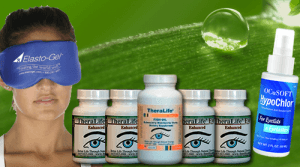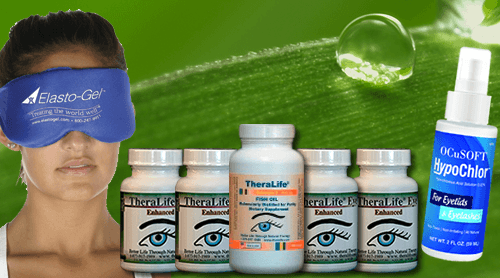Theralife.com’s range of products offers significant benefits for customers dealing with various eye conditions, including blepharitis. Their formulas, infused with omega-3 fatty acids, are particularly effective in reducing eyelid inflammation and promoting tear film stability, which can alleviate symptoms such as redness and irritation. By modulating inflammatory responses, these products help to alleviate discomfort naturally. Consistent use is essential for optimal results, as individual experiences may vary. Theralife.com’s offerings are designed to enhance ocular health and provide relief from common eye conditions, making them a valuable addition to any eye care routine.
Best Blepharitis Treatment From TheraLife
Add To CartKey Takeaways
- Omega-3s reduce inflammation and improve eyelid health, benefiting those with blepharitis.
- DHA and EPA from fish oil support tear production and meibomian gland function.
- Fish oil’s anti-inflammatory properties enhance tear film stability, soothing blepharitis symptoms.
- Consuming omega-3-rich foods like mackerel and salmon helps manage blepharitis effectively.
- Consult a healthcare provider for appropriate fish oil dosage to avoid potential side effects.
Understanding Blepharitis: Symptoms and Causes
When you’re dealing with blepharitis, understanding its symptoms and causes is crucial for effective management.
Blepharitis, characterized by inflammation of the eyelid margins, commonly presents with symptoms like redness, swelling, itching, and crusting around the eyelashes. The condition results from bacterial infections or skin conditions like seborrheic dermatitis.
For accurate blepharitis diagnosis, a clinical examination by an eye care professional is necessary. They may assess eyelid condition, tear film stability, and gland function.
Preventing blepharitis involves maintaining eyelid hygiene. Regular eyelid cleaning with warm compresses and gentle scrubbing can help minimize bacterial buildup.
The prevalence of blepharitis is high, affecting various demographics, and it can significantly impact the quality of life for those affected.
Consider lifestyle modifications to reduce exposure to potential irritants. Early diagnosis and consistent preventive measures are crucial for mitigating symptoms and preventing recurrent flare-ups.
Traditional Treatments for Blepharitis
Effective management of blepharitis often requires a multifaceted approach, where traditional treatments play a key role. These treatments focus on reducing inflammation and maintaining eyelid hygiene. It’s essential to integrate natural remedies and consistent hygiene practices into your routine. Consider these three steps:
- Warm Compresses: Apply a warm compress to your eyelids to help loosen crusts and improve glandular secretion. This natural remedy can alleviate discomfort and improve eyelid function.
- Eyelid Scrubs: Use a gentle eyelid scrub or diluted baby shampoo to clean your eyelid margins. This hygiene practice helps remove debris and bacteria that exacerbate blepharitis.
- Lubricating Eye Drops: Employ preservative-free artificial tears to maintain moisture and soothe irritation. Regular use supports the eye’s natural defenses and eases symptoms.
Additionally, incorporating fish oil supplements into your daily regimen can help reduce inflammation, as omega-3 fatty acids serve as natural anti-inflammatories and tear thickeners, promoting overall eye health.
What Are Omega-3 Fatty Acids?
Omega-3 fatty acids are essential nutrients that play a fundamental role in maintaining cellular function and reducing inflammation. These polyunsaturated fats are imperative for overall health benefits, influencing heart, brain, and eye health. You can find dietary sources of omega-3s primarily in fatty fish, such as salmon and mackerel, as well as in flaxseeds and walnuts. Understanding these sources is key to optimizing intake. Omega-3s, particularly DHA and EPA, are essential fatty acids that contribute significantly to eye health and may help alleviate dry eye symptoms.
| Omega-3 Type | Source | Health Benefits |
|---|---|---|
| EPA | Fish oil | Reduces inflammation |
| DHA | Algae oil | Supports brain function |
| ALA | Flaxseeds | Converts to EPA and DHA |
| EPA | Mackerel | Heart health improvement |
| DHA | Salmon | Eye health maintenance |
Incorporating a variety of these sources into your diet guarantees you receive thorough benefits, emphasizing their role in reducing inflammation and maintaining cellular health.
The Anti-Inflammatory Benefits of Omega-3s
You can harness the anti-inflammatory effects of omega-3 fatty acids to reduce eye inflammation associated with blepharitis. Key sources of omega-3s include fish oil, which has been shown in clinical studies to provide significant relief from inflammation. Incorporating these fatty acids into your diet may offer substantial benefits in managing the symptoms of blepharitis. TheraLife Omega-3 is purified via molecular distillation to ensure the removal of contaminants and provide a high-quality supplement option.
Reducing Eye Inflammation
Although often underestimated, the anti-inflammatory properties of omega-3 fatty acids play an essential role in reducing eye inflammation associated with blepharitis.
These essential nutrients enhance your eye hygiene and eyelid care routine, offering a multifaceted approach to managing symptoms. Omega-3s work by modulating inflammatory mediators in the body, thereby reducing swelling and discomfort in the eyelids.
Here’s how omega-3s can improve your condition:
- Regulate Inflammatory Cytokines: Omega-3s help control the production of cytokines, proteins that drive inflammation in blepharitis.
- Enhance Meibomian Gland Function: By improving gland function, omega-3s reduce tear film instability, a common issue in blepharitis.
- Support Tear Production: Adequate omega-3 intake can boost tear secretion, promoting better eye lubrication.
Integrating omega-3s into your regimen could complement conventional treatments effectively. Omega-3 Fish Oil Benefits include helping to thicken natural tears and prevent evaporation, which are crucial for maintaining eye health.
Omega-3 Sources Explained
When exploring dietary sources of omega-3 fatty acids, it is crucial to understand their specific roles in reducing inflammation linked to blepharitis. Omega-3s are divided into ALA, EPA, and DHA types. ALA, found in plant-based sources like flaxseeds and walnuts, converts into EPA and DHA in your body, albeit inefficiently. EPA and DHA are primarily obtained from marine sources, but omega 3 supplements can provide these in concentrated forms. By decreasing inflammatory markers, omega-3s can alleviate blepharitis symptoms. Restoring natural tear production ability is essential in managing dry eye symptoms, as it helps to eliminate painful inflammation and dryness.
| Omega-3 Type | Source | Conversion/Absorption |
|---|---|---|
| ALA | Flaxseeds, Walnuts | Converts to EPA/DHA |
| EPA | Fish Oil, Krill Oil | Direct absorption |
| DHA | Algae Oil, Fish Oil | Direct absorption |
Understanding these sources helps you optimize intake for anti-inflammatory benefits.
Fish Oil Benefits
Harness the power of fish oil to combat inflammation with its rich omega-3 content. Omega-3 fatty acids, primarily EPA and DHA found in fish oil, play a pivotal role in maintaining eye health by reducing inflammation associated with blepharitis.
Clinical studies suggest that incorporating omega-3s into your diet can result in significant improvements in ocular comfort. By targeting inflammatory pathways, these fatty acids help alleviate symptoms such as redness and irritation.
Consider the following benefits:
- Anti-inflammatory properties: Omega-3s reduce the production of inflammatory mediators, easing discomfort.
- Improved tear production: Regular intake promotes healthier tear composition, enhancing lubrication.
- Reduced dry eye symptoms: Omega-3s support overall eye health, mitigating dryness.
Incorporating fish oil supplements might be a beneficial strategy for managing blepharitis effectively.
Scientific Studies on Omega-3s and Eye Health
Scientific studies indicate that omega-3 fatty acids can enhance tear production and exert anti-inflammatory effects on ocular tissues. You’ll find that research supports these benefits, particularly in the context of managing conditions like blepharitis. Consistent omega-3 intake has been shown to improve overall eye health by reducing inflammation and supporting the tear film. Additionally, omega-3s may help address underactive tear production, a root cause of chronic dry eyes, thereby providing relief from symptoms.
Omega-3s Improve Tear Production
While there’s widespread belief in the benefits of omega-3 fatty acids for eye health, scientific evidence on their role in improving tear production remains inconclusive.
Yet, many studies suggest that omega 3 benefits could include tear enhancement. Clinical trials have explored how these essential fatty acids might support ocular surface health and overall tear quality.
Here are some key findings:
- Study Designs: Various randomized controlled trials have assessed omega-3 supplementation’s impact on tear production, but results vary considerably.
- Tear Volume: Some research indicates a potential increase in tear volume among participants taking omega-3 supplements, though not all studies confirm this.
- Ocular Surface: Improvements in ocular surface health, potentially leading to enhanced tear stability, have been observed in certain studies.
People suffering from autoimmune conditions like Sjogren’s syndrome might benefit from omega-3s to improve their eye health.
These studies underline the need for further research.
Anti-Inflammatory Effects on Eyes
Emerging research highlights omega-3 fatty acids’ anti-inflammatory properties, which might play a significant role in eye health.
Studies suggest that omega-3s can reduce inflammation, a key factor in managing conditions like blepharitis. By decreasing the production of inflammatory cytokines, these fatty acids may help alleviate symptoms associated with chronic eye discomfort.
Clinical trials have shown that omega-3 supplementation leads to improved inflammation management, resulting in healthier ocular surfaces.
Incorporating omega-3s into your diet, either through fish oil supplements or fatty fish consumption, could enhance your eye health by mitigating inflammatory processes.
Although more research is needed to fully understand the mechanisms, current evidence supports the therapeutic potential of omega-3s in reducing ocular inflammation, providing relief for those suffering from inflammatory eye conditions.
Adding an autoimmune diet can further aid those with inflammatory eye conditions by reducing gut inflammation, which is often linked to autoimmune responses affecting eye health.
How Omega-3s May Alleviate Blepharitis Symptoms
Omega-3 fatty acids may play a beneficial role in alleviating symptoms of blepharitis. These essential fatty acids are renowned for their anti-inflammatory properties, which can help reduce eyelid inflammation and irritation.
Clinical studies suggest that incorporating omega-3s into your diet can contribute to healthier tear film composition, potentially easing the discomfort associated with blepharitis.
Here’s how omega-3s may assist:
- Omega-3 Sources: Consuming foods rich in omega-3s, such as fatty fish, flaxseeds, and walnuts, can be advantageous for ocular health.
- Omega-3 Dosage: Research indicates that an appropriate dosage is vital for achieving therapeutic effects, although individual requirements may vary.
- Tear Film Stability: Omega-3s enhance the lipid layer of the tear film, promoting stability and reducing tear evaporation.
Incorporating omega-3s offers a promising approach to managing blepharitis symptoms.
Recommended Sources and Dosage of Omega-3s
To enhance the benefits of omega-3s for blepharitis, it is important to focus on both the sources and the dosage of these fatty acids. Dietary considerations should include rich sources like fish and flaxseed oil. Research suggests a daily intake of 1000-2000 mg of combined EPA and DHA for ocular health. However, individual dosage recommendations may vary based on dietary intake and specific health needs.
| Source | Omega-3 Content (mg) |
|---|---|
| Salmon (100g) | 2260 |
| Flaxseed Oil | 7190 per tablespoon |
| Chia Seeds | 4915 per ounce |
| Walnuts | 2542 per ounce |
Consult with a healthcare provider to tailor the dosage to your needs, ensuring the best support for blepharitis management. Balancing these elements is vital for achieving therapeutic outcomes.
Potential Side Effects and Considerations
While omega-3 fatty acids are generally considered safe, it’s important to be aware of potential side effects and considerations when using them for blepharitis management.
Though rare, some individuals might experience mild gastrointestinal issues, such as nausea or diarrhea. It’s vital to discuss dosage considerations with your healthcare provider to guarantee maximum benefits while minimizing risks. Overconsumption can lead to complications, so adhere to recommended guidelines.
Consider these factors:
- Allergic Reactions: If you’re allergic to fish or shellfish, be cautious, as omega-3 supplements may trigger reactions.
- Medication Interactions: Omega-3s can interact with anticoagulants, increasing bleeding risk.
- Quality of Supplements: Choose high-quality, reputable brands to avoid contaminants like mercury.
Combining Omega-3s With Other Blepharitis Treatments
Although managing blepharitis often requires a multi-faceted approach, integrating omega-3 supplements with other treatments may enhance therapeutic outcomes.
Combination therapies, including warm compresses, lid hygiene, and topical antibiotics, can benefit from the synergistic effects of omega-3 fatty acids. These supplements may reduce inflammation and improve meibomian gland function, potentially increasing the efficacy of conventional treatments.
Clinical studies suggest that omega-3s may complement topical cyclosporine by mitigating ocular surface inflammation and promoting tear film stability.
However, it’s crucial to tailor treatment plans to individual needs and monitor patient response closely. Discussing omega-3 supplementation with your healthcare provider can guarantee safe integration into your regimen, maximizing the potential benefits while minimizing the risk of adverse interactions.
Frequently Asked Questions
Can Diet Affect Blepharitis Symptoms Aside From Omega-3 Intake?
Absolutely, your diet can affect blepharitis symptoms beyond omega-3 intake.
Consider making dietary adjustments to reduce inflammation. Incorporating foods rich in antioxidants, like leafy greens and berries, can support eye health. Reducing intake of processed foods and sugars may also help.
Evidence suggests that anti-inflammatory diets, emphasizing whole foods and healthy fats, can clinically reduce ocular inflammation, potentially easing blepharitis symptoms.
Always consult with a healthcare provider for personalized advice.
Are There Specific Fish High in Omega-3 That Benefit Eye Health?
You’re wondering if specific fish high in omega-3 benefit eye health.
Sardines, rich in omega-3 fatty acids, offer significant benefits for reducing inflammation and promoting eye health.
Salmon, another excellent source, provides essential nutrients like DHA and EPA, critical for maintaining peak eye function.
Consuming these fish regularly can improve tear production and overall eye comfort.
Clinical studies support these findings, reinforcing the importance of omega-3-rich fish in your diet for eye health.
How Long Does It Take to See Results From Omega-3 Supplements for Blepharitis?
To see results from omega-3 supplements for blepharitis, you should typically allow an omega 3 timeline of about 6 to 12 weeks.
This period accounts for the time necessary for anti-inflammatory effects to manifest.
Make sure you’re taking the recommended supplement dosage, usually around 1000 mg of combined EPA and DHA daily.
Clinical studies suggest this dosage effectively reduces symptoms, but individual responses can vary, so monitor your progress closely.
Can Omega-3s Interact With Other Medications Used for Blepharitis?
When you’re steering through the waters of drug interactions, it’s vital to take into account how omega-3s might interact with blepharitis medications.
While clinical evidence suggests omega-3 supplements typically have minimal interactions, it’s important to assess dosage considerations carefully.
Always discuss with your healthcare provider before starting omega-3s, as they can affect blood thinning agents.
Keeping an eye on your overall medication regimen will guarantee you’re on the right track for treating blepharitis effectively.
Are There Any Non-Fish Sources of Omega-3 Suitable for Vegetarians?
You’re wondering about vegetarian alternatives for omega-3s.
Plant-based sources like flaxseeds, chia seeds, and walnuts are great options. Algal oil is another excellent choice, derived directly from algae, rich in DHA and EPA.
Clinical studies have shown these sources provide adequate omega-3 levels comparable to fish-based supplements.
Conclusion
Theralife.com offers a comprehensive range of products designed to enhance eye health and address conditions like blepharitis, dry eyes, and more. By focusing on natural and holistic solutions, Theralife products aim to soothe inflammation, improve comfort, and promote clearer vision. These products serve as a beneficial complement to traditional treatments, potentially easing symptoms through a gentle and effective approach.
With an emphasis on customer well-being, Theralife provides detailed guidance on incorporating their supplements into daily routines, while also considering individual needs and potential side effects. Their expert advice ensures that customers can navigate the path to improved eye health with confidence and support.
As always, it is essential to consult with healthcare providers when introducing new supplements or treatments to ensure they align with personal health requirements. With Theralife, you can embark on a journey to more comfortable and healthier eyes.





